The Books That Shaped Them
Summer: a time to catch up on neglected projects, reconnect with old friends and tackle that summer reading list.
Summer: a time to catch up on neglected projects, reconnect with old friends and tackle that summer reading list.
In Johnson County, Kentucky, today, lots of people along Patterson Creek are wondering “why me?” A flash flood Monday (July 13) tore through that eastern Kentucky community, leaving three people dead, a dozen missing at one point, and destroying about 150 homes and who knows how many cars, barns, etc. (news story).
As a Kentuckian, and as a veteran of a couple of hurricanes back in 1996 in North Carolina, I sympathize with wondering why you, or your community, got hit while others didn’t. As a geomorphologist and hydrologist who was worked on flash flooding in the southern Appalachians, I also wonder about the scientific aspects—why the severe flood event in this particular location?
Make no mistake—the area around Flat Gap is not the only one in Kentucky that has gotten a lot of rain recently, and high water, runoff, soil erosion, and filled-up sinkholes are common lately throughout eastern and central Kentucky. But why the much more severe flooding at Patterson Creek?
Did they get more rain?
The online version of my new article exploring biogeomorphology from the perspective of niche construction and extended phenotypes is now out. The abstract is below. I appreciate my colleague Daehyun Kim encouraging me to stick with some of the more speculative and provocative ideas here. I was about to back off from them at one point, but he encouraged me to go for it.

Reference: Phillips, J.D. 2015. Landforms as extended compositive phenotypes. Earth Surface Processes and Landforms DOI: 10.1002/esp.3764.
In common parlance, romantic typically refers to the pursuit of love and affection, or to an idealistic, unrealistic outlook. The definitions of romantic as idealistic often includes synonyms such as dreamy, starry-eyed, impractical, and Quixotic, and may list realistic as an antonym. However, Romanticism (typically indicated with the capital R to distinguish it from other usages) as a movement of the late 18th and early 19th century applied to science as well as to art and literature. Lately I’ve stumbled across a few things that made me want to play with the idea of what a Romantic geomorphologist would be like.
This weekend Lexington will be in the spotlight as C-SPAN airs coverage of the city as part of its "2015 C-SPAN Cities Tour." Viewers of "Lexington Weekend" will learn about the city's rich history, as well as the community's non-fiction literary culture on programming
 No, not like this.
No, not like this.
Dang, it’s been raining a lot lately. Today, for instance, here in Mercer County, Kentucky, Herrington Lake’s level has risen almost 2 m in the last two weeks. Discharge of the Dix River has topped 1000 cfs (28.3 cms) twice in the past week, where the mean flow for early July is about 40 cfs (1.1 cms) over the past 71 years. We had another gully-washer, frog-choker rainstorm this morning.
If it seems to have been an unusually wet summer here in Kentucky, you’re right. The graphic below shows departures from normal (mean) rainfall totals for June. That pinkish blob in north-central Kentucky, showing 8 inches (203 mm) above normal is the Lexington area.

This follows a wet spring hereabouts. Below is the departure-from-normal precipitation map for April, 2015, a month in which one-day precipitation records were set in Lexington, Frankfort, and Louisville.

So is there a point, other than griping about a wet spring and summer?
This rant, lament, or diatribe will not be unfamiliar to those who know me, or to most academics, as there’s scarcely a unique complaint here. I reprise it in response to a couple of recent conversations. One concerned a very good geoscientist at another university who was recently promoted and tenured, but told by her dean that she would never make full professor if she didn’t start bringing in some grant money, regardless of the quantity and quality of her research output. The attitude and policy reflected by this is not only not atypical, it is standard in research universities. For a long time academic success (at least in material terms of money and status) in the sciences has depended more on how many external dollars you bring in than how much research you produce, and how good that research is.
The second conversation involved a young scientist venting a bit about what a royal pain in the ass it is putting together a joint proposal. I know from experience that many will agree with me when I say that the administrative details, budget, chain of internal and external approvals, and other miscellaneous hoop jumping is invariably a lot more work than the actual scientific part of a proposal.
University of Kentucky Office of Nationally Competitive Awards has announced that six UK students have been named recipients of Fulbright U.S. Student Program scholarships.
First part is here.
An oversimplified, drive-by version of the changing role of physical geography includes these overlapping and not mutually exclusive stages:
1. Discovery and exploration—collecting basic data and observations on topography, geology, biota, meteorology, oceanography, etc., often in conjunction with surveying, mapping, and collection of anthropological and economic data. In this stage physical geographers are simply, but not exclusively, Geographers. They are also, in various cases, anthropologists, biologists, ethnographers, geologists, meteorologists, oceanographers, and surveyors.
2. Holding up the Earth and environmental sciences end of the integrated geographical analysis of places, regions, and various geographical systems (e.g., transportation and settlement patterns, trade networks, cultural landscapes, climate zones, biomes, agricultural systems, etc.). Physical geographers in this stage were either specialists in the physical side of the discipline, or broadly trained geographers with substantive physical expertise.
In support of the College of Arts and Sciences’ Passport to the World Initiative and the 2015 Year of the Middle East campaign, University of Kentucky Education Abroad partnered with the college